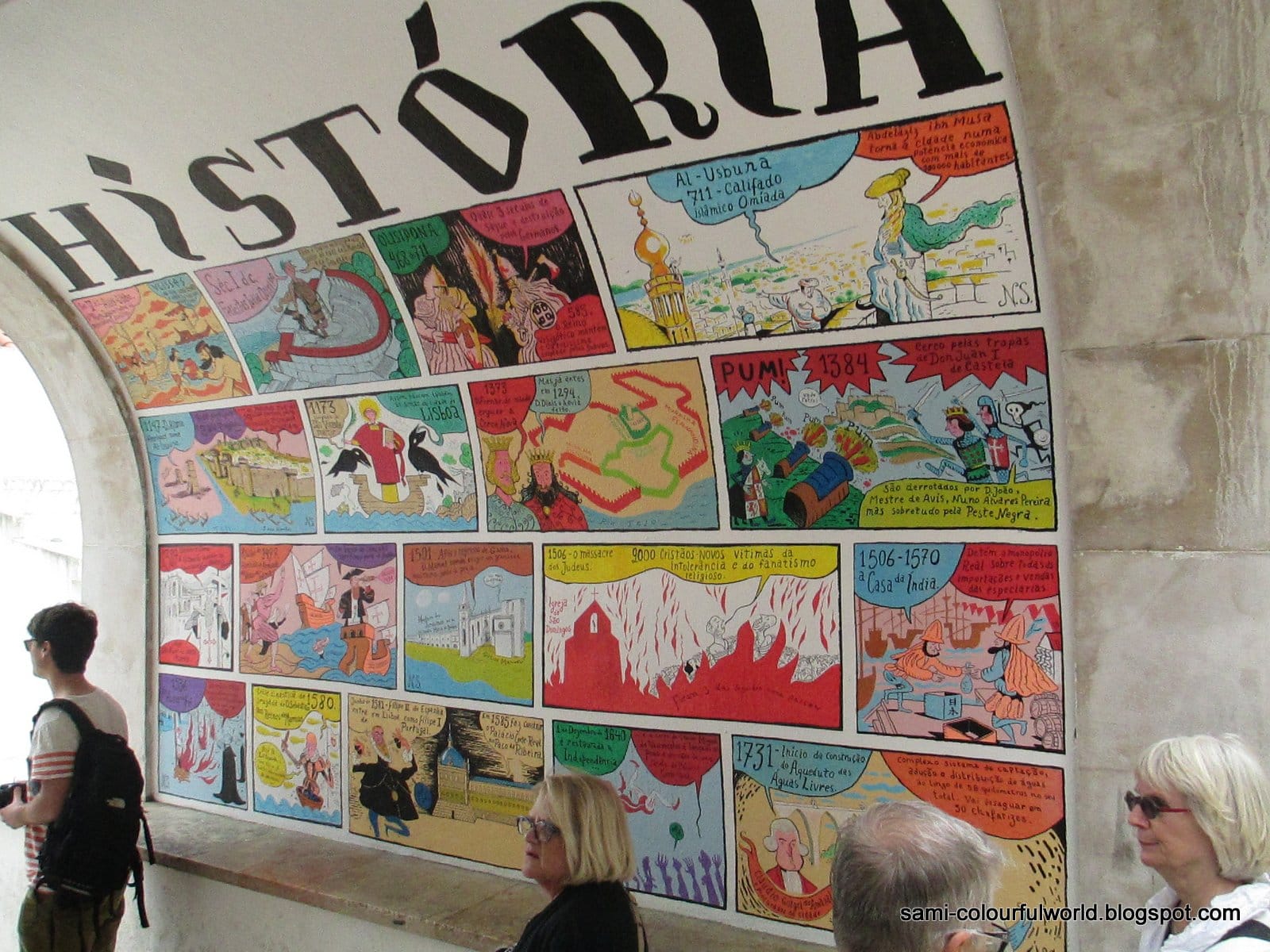Imagine stepping into a city where history and art intertwine, creating a captivating tapestry of stories. Lisbon, a city steeped in centuries of triumphs and tribulations, boasts a mural that has become a symbol of its vibrant spirit. Painted by renowned Portuguese street artist Nuno Saraiva, this masterpiece narrates the tale of Lisbon’s rich past and colorful present. Join us as we uncover the captivating story behind this iconic mural and how it became a beloved landmark in this bustling city.
History of Lisbon Mural by Nuno Saraiva
Nestled within a Lisbon tunnel, Nuno Saraiva’s “History of Lisbon” mural is no ordinary history lesson. Imagine a giant, colorful comic strip bursting with life, taking you on a whirlwind tour of the city’s past – that’s the magic Saraiva creates. He doesn’t merely tell Lisbon’s story; he paints it in vivid detail, making history come alive for everyone, from locals rediscovering their city to curious travelers eager to explore its depths.
Beginning with Lisbon’s early days as a Phoenician settlement, the mural unfolds like a giant storybook, each panel a new chapter leading you through the ages. You’ll encounter pivotal moments that shaped Lisbon, from Roman rule and Moorish influences to devastating earthquakes and revolutionary upheavals. It’s like stepping into a time machine, with Saraiva as your guide, his art making the past feel strikingly present.
The tunnel itself plays a crucial role in this experience. It’s not just a backdrop; it becomes part of the story. The enclosed space shuts out the outside world, allowing you to fully immerse yourself in the flow of history as it washes over you.
However, this immersive quality has, unfortunately, encountered some challenges. One side of the tunnel has been partially covered, obscuring some of the mural’s flow. Additionally, its location within a less-than-ideal area might discourage some from fully appreciating Saraiva’s masterpiece. These obstacles highlight the ongoing discussion about art accessibility and preservation, especially when it comes to unconventional canvases like this one.
Despite these hurdles, the mural’s power remains undeniable. Its ability to educate and inspire continues to draw people in, offering a unique perspective on Lisbon’s rich tapestry of events.
There are, however, ways to enhance the experience even further. Imagine strolling alongside the mural with a knowledgeable guide, delving deeper into its symbolism and the artistic choices Saraiva made. Alternatively, picture audio guides whispering historical tidbits and anecdotes directly into your ear, enriching the visual feast with layers of context. These additions could transform an already engaging experience into a truly unforgettable journey through time.
Ultimately, the “History of Lisbon” mural stands as a testament to the city’s enduring spirit and ever-evolving story. It’s a reminder that history isn’t just dates and names confined to textbooks; it’s a living, breathing entity, and Saraiva’s art invites us to experience it firsthand.
Is Lisbon Older than Rome?
We’ve established that Lisbon is incredibly old, but can it truly claim to be older than Rome? That city with gladiators, emperors, and enough history to fill a thousand textbooks? Well, believe it or not, it’s true! Lisbon might not have the Colosseum, but it boasts a few centuries on Rome, which is certainly something to write home about! We’re talking about a head start of roughly 400 years! That means when Lisbon was a bustling Phoenician trading post way back in the 12th century BC, the land where Rome would eventually stand was likely just a peaceful pasture.
You see, Lisbon had this prime location – a natural harbor perfectly positioned for access to the Atlantic Ocean. It was like the ancient world’s version of a coastal megacity, attracting everyone who was anyone. The Phoenicians, expert sailors and traders, recognized this potential and decided to set up shop.
Rome, conversely, got its start a little later in 753 BC. Don’t get me wrong, they made up for lost time, building an empire that stretched across Europe and leaving behind a legacy of art, architecture, and culture that continues to captivate us today. They had their Colosseum, their emperors, their senators debating in togas – they were the ancient world’s superpower, no doubt about it!
But when it comes to sheer age, Lisbon takes the prize, claiming the title of the second-oldest capital city in Europe. So next time you’re pondering the vastness of history, remember that sometimes, the places you’d least expect hold the most surprising stories – stories whispered on the salty winds of the Atlantic, stories etched into the ancient stones of a harbor city named Lisbon.
Was Lisbon Founded by the Phoenicians?
Lisbon possesses a past shrouded in mystery, a city that’s seen countless civilizations come and go, all leaving their own unique mark. And amongst them, the Phoenicians, those intrepid seafarers, hold a special place in the story of Lisbon’s beginnings.
Consider this: These seafaring traders, famous for their voyages across the Mediterranean, likely dropped anchor right here in Lisbon around 1200 BC! They called their settlement Ulissipo, and it quickly flourished, becoming a bustling trading hub strategically placed where the Tagus River meets the Atlantic Ocean. Some historians even suggest that Lisbon’s very name might have roots in the Phoenician phrase “alis ubbo,” which translates to “pleasant bay” – it seems quite fitting, doesn’t it?
Now, picture this: Lisbon, ideally situated at the mouth of the Tagus River, was like a giant welcome mat for ships from all corners of the ancient world. The Phoenicians, being the clever merchants they were, saw this and seized the opportunity. They established trade routes that stretched across the Mediterranean and beyond, making Ulissipo a key player in their network. Imagine ships laden with luxurious fabrics, exotic spices, and precious metals all passing through Lisbon’s port – it must have been quite a sight!
But it wasn’t just about trade; the Phoenicians left their mark on Lisbon in more ways than one. Their influence seeped into the local culture, leaving behind echoes that can still be felt today. They were like the trendsetters who arrived and transformed everything, paving the way for Lisbon’s eventual rise as a major port city, a place where cultures collided and history was made.
It’s important to acknowledge that while a lot of evidence points to the Phoenicians establishing a significant presence in Lisbon, research is ongoing. Archaeologists are always unearthing new clues that help us piece together the city’s past. However, there’s still some debate about whether they were the absolute first to settle here. Some scholars believe that even before the Phoenicians arrived, other groups might have already called Lisbon home. It’s like a giant jigsaw puzzle, and we’re still trying to fit all the pieces together.
So, did the Phoenicians definitively found Lisbon? The evidence strongly suggests they played a crucial role, laying the groundwork for the vibrant city we know today. But like with many things from the distant past, a bit of mystery remains, making Lisbon’s story all the more intriguing!
What is the History of Lisbon, Portugal?
Picking up where we left off, Lisbon’s story doesn’t end with ancient civilizations. Remember how it’s nestled on the Tagus River? Well, that prime location turned it into a bustling port, a magnet for traders and explorers. Think back to the Age of Exploration – Lisbon was right in the thick of it! Portuguese explorers set sail from its harbor, discovering new lands and making Portugal a global powerhouse.
Now, fast forward to 1755. A massive earthquake rocks Lisbon, a devastating event that reshaped the city, literally. But the people of Lisbon are resilient. They rebuilt, incorporating new architectural styles and city planning. That’s why today, you can stroll through Lisbon’s charming neighborhoods, like the Alfama, with its narrow, winding streets, and then be awestruck by the grand plazas and buildings constructed after the earthquake.
Here’s where things get really interesting. Historians generally agree that Lisbon is one of the oldest capital cities in Europe. Some even argue it might be the second oldest, right after Athens. But remember, history is full of twists and turns, and new discoveries are always possible.
Let’s circle back to those Phoenicians. It’s widely believed they established a trading post around 1200 BC, laying the groundwork for what would become Lisbon. Then, the Romans marched in around 205 BC, renaming the city “Olissipo.” Fast forward a few centuries, and the Moors, from North Africa, made their mark, ruling Lisbon for over 400 years. It was a time of cultural exchange, leaving behind architectural influences you can still see today.
In 1147, the tide turned again. Christian crusaders captured Lisbon, and by 1256, it became the capital of Portugal. Imagine that – Lisbon has been the heart of Portugal for almost 800 years!
So, when you wander through Lisbon’s streets today, soaking up the lively atmosphere, remember that you’re walking through layers upon layers of history. Each building, each neighborhood whispers tales of ancient civilizations, explorers, earthquakes, and the unwavering spirit of the Lisbon people.
What is the Arabic Name for Lisbon?
We’ve been discussing Lisbon’s fascinating history, and one of the coolest parts is how the city’s past with Arabic culture still shines through today – even in its name!
You see, “Lisbon” as we know it likely started out as “Al-Ushbuna” during the period when Arabic was commonly spoken in the region. Why that particular word? Well, historians speculate that it might have been a variation on the older name, “Olisipo,” which was used way back in the day.
But here’s the thing – language is dynamic, always evolving! Over time, “Al-Ushbuna” probably underwent a series of subtle pronunciation shifts. You know how people sometimes slur words together or drop sounds? It’s kind of like that! And eventually, it morphed into our familiar “Lisbon.” Pretty neat, huh?
Is Lisbon the Oldest City in the World?
We’ve established that Lisbon is incredibly old, like really old. When we say it’s one of the oldest cities in Europe, we’re not exaggerating. It’s second only to Athens, which is saying something! But the question remains: Is Lisbon the oldest city in the world?
To answer that, we need to journey back in time, way back to the 12th century BC. Imagine a world before Rome, even before the Roman Republic was a twinkle in anyone’s eye. That’s when the adventurous Phoenicians, known for their seafaring skills and trading savvy, sailed up the Tagus River and decided this would be an ideal location for a settlement. They called it Ulissipo, and that, my friends, was the seed that would eventually blossom into the Lisbon we know and love today.
Now, some folks might say, “Hold on! What about cities in Mesopotamia or ancient Egypt? Aren’t they way older?” And they wouldn’t be wrong! Those civilizations were incredibly ancient, with cities dating back millennia. However, it all boils down to how we define “oldest.” Some cities might have older foundations, buried deep beneath layers of history. But Lisbon? Lisbon’s story has been unfolding continuously in the same location for over three thousand years. That’s pretty impressive!
Think about all the different groups who have called Lisbon home over the centuries: Romans, Visigoths, Moors, and eventually, the Portuguese. Each civilization left its own unique imprint, shaping the city’s architecture, culture, and even its language. Walking through Lisbon’s charming neighborhoods today is like stepping back in time, with echoes of the past whispering around every corner.
Of course, the question of the absolute oldest city is still up for debate. New discoveries are made all the time, and archaeologists are constantly digging deeper into the history of our planet. It’s an ongoing conversation, and who knows what fascinating secrets we might uncover in the future?
But one thing’s for sure: Lisbon’s place in history is secure. It’s a city that has witnessed empires rise and fall, survived earthquakes and invasions, and emerged as a vibrant, cosmopolitan hub with a story that spans millennia. And that, more than any title, is what makes Lisbon truly remarkable.
Is Portugal the Oldest Country in Europe?
So, we’ve been discussing how old Portugal is, and it’s definitely up there as one of the oldest nation-states in Europe, with a history that goes way back. But is it the oldest? Well, not quite. That title actually goes to a tiny little country you might not even have heard of – San Marino.
This micro-state, nestled right inside Italy, has been around since the year 301 CE, which is seriously ancient! Now, that doesn’t mean Portugal is exactly a spring chicken. It has a pretty impressive claim to fame when it comes to borders. We’re talking about borders that have basically stayed the same since the mid-13th century – that’s older than some of the world’s most famous landmarks!
To put things into perspective, consider Portugal’s neighbor, Spain. While Spain is no newbie to the history books, Portugal declared its independence way back in 1143, while Spain didn’t follow suit until 1492. That’s a significant head start!
Think of it this way:
Imagine Europe as a giant puzzle. Some of the pieces, like San Marino, have been sitting there pretty much untouched for ages. Others, like Portugal, came together a bit later but then stayed remarkably consistent. And then you have pieces that have shifted and changed quite a bit over time.
What’s fascinating is this:
The idea of what constitutes a “country” can be a bit blurry. Some experts might argue that a country’s age is tied to its current borders, while others might say it’s more about continuous cultural identity, which can be much harder to pinpoint.
The bottom line?
Portugal might not be the absolute oldest country in Europe if you’re going by the date it was established, but it’s certainly one of the most enduring, with a history that’s both rich and captivating.
If you’re a fan of captivating stories and intriguing histories, you won’t want to miss these:
- Dive into the intriguing world of K-drama with the history of losers kdrama.
- Discover the fascinating history of lox and bagels and explore the origins of this beloved culinary combination.
- Gear up for a thrilling journey as you delve into the history of McCulloch chainsaws and their impact on forestry and woodworking.
- SYBAU See You Baby Meaning: Gen Z Slang Evolves - July 1, 2025
- Unlock Your Inner Youth: Lifestyle Secrets for a Vibrant Life - July 1, 2025
- Decode SYBAU Meaning: Gen Z Slang Explained - July 1, 2025







2 thoughts on “Unveiling Lisbon’s Artistic Heritage: The Story Behind Nuno Saraiva’s Iconic Mural”
Comments are closed.